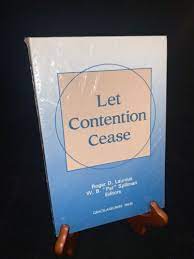Articles/Essays – Volume 25, No. 3
Assessing Conflict | Roger D. Launius and W. B. “Pat” Spillman, eds., Let Contention Cease: The Dynamics of Dissent in the Reorganized Church of Jesus Christ of Latter Day Saints
Religious conflict, dissent, and schism rarely have been examined in a critical, balanced, and systematic fashion. Social order, harmony, cooperation, and conformity commonly are considered normal, desirable, and good; while social change, conflict, competition, and nonconformity are considered bad. Religions, however, exhibit at least as much conflict, violence, and fragmentation as equilibrium, tranquility, and cohesion. Paradoxically sectarianism additionally compounds religious conflict: religions commonly assert themselves as the only True Religion, defending and legitimating their claims with literalistic accounts of past and present events. Sacred stories (myths) are invaluable, but they should not be con fused with the products of academic discipline. Religious mythologies and scholastic interpretations are different and serve distinctive purposes. To ignore religious conflict or to interpret it as merely a form of deviance or uniformly detrimental reflects a misunderstanding of the complexity of religion.
This collection of nine original essays, focused on conflict, dissent, and schism within the RLDS Church, is a significant, exploratory effort to treat and overcome persistent deficiencies in scholarly perspective and thought. Most of the authors are RLDS; some are church officials, although none of them speak for the church. They all hold impressive aca demic credentials. They boldly pronounce the RLDS faith as a tradition of debate, dissent, and nonconformity sometimes resulting in disaffection, repudiation, and fragmentation. The contributors examine conflict and dissent from multiple theoretical viewpoints without prejudice. Their essays enhance our understanding of criticism, disagreement, division, and related social processes within a religious organization and evaluate both the position and the consequences of conflict, as well as ways of ameliorating the problems resulting from discord. The book’s organization is coherent and systematic, addressing the history of the RLDS movement and splinter organizations and the poli tics, sociology, theology, and ethics of dis sent, specifically that of the last twenty years. Each essay is credible and read able and several are truly outstanding.
Pat Spillman’s preface briefly intro duces the book. Roger Launius master fully interprets Mormonism’s early history and the emergent RLDS movement, convincingly arguing the pivotal contention that the Reorganization was a tradition of pluralistic dissent. An efficacious overview of leading dissenters and splinters is supplied by Steven Shields. Kenneth Mulliken’s historical narrative illuminates the “supreme directional control controversy” of Frederick Smith’s presidency, astutely analyzing and interpreting it through the enigmatic Latter Day Saint concept of theocratic-democracy. The division between RLDS fundamentalists and liberals which developed during the late 1950s, subsequently fueling dissent and segmentation, is described in rich detail by William Russell. His painstaking investigation, penetrating analysis, and sensitive, trenchant interpretation of RLDS fundamentalism enlightens other essays in this collection and establishes the rationale for subsequent inquiries. Separate chapters by Donald Breckon and Maurice Draper furnish useful compendiums of the political and sociological aspects of religious dissention.
Larry Conrad’s analysis and interpretation of RLDS theology, focusing on the fundamentalist/progressive fissure, is at once disturbing and fascinating. His assessment of a current crisis in RLDS theology, resulting from a breakdown of previous consensus, is sagacious; yet a more orderly inspection of the dismemberment of the franchise—based on Conrad’s superb previous research—would have been fruitful. The “Protestantism” to which RLDS progressives have been attracted is overworked and too vague. His obvious disdain for Mormon orthodoxy is unwarranted, and the use of “mainstream Protestantism” resembles a thinly dis guised, secularized sectarianism. His criticisms that progressives have neglected tradition, abused political power through centralized authority, and missed an opportunity to re-examine the priesthood concept in ordaining women are insightful and constructive. His rationalistic concern for theology does not acknowledge adequately that religion lives in the experiences, meanings, and activities of its members, notwithstanding theological dis array and ferment. Even so, Conrad’s challenge magnifies crucial propositions and promises to promote much needed debate and discussion.
Paul Edwards’ essay on the ethics of dissent is personal and deeply moving, filled with witty, yet profound, biting philosophical insights, and always delightfully cynical. In a concluding chapter, Pat Spillman weaves together re views of the history of dissent in the RLDS Church and a sociological interpretation which sees the movement being transformed from a “sect” into a “denomination.” The collection concludes with Roger Launius’s “suggestions for further reading.”
Though only a beginning, this energizing work should initiate greater scholarly interest in conflict, dissent, and schism within Mormonism. In spite of efforts to expand the discussion to Mormonism generally (especially by Launius and Edwards), this book is about the Reorganization. Though the debated issues may seem strange and unfamiliar to RLDS outsiders, this volume makes them accessible. Confirming the book’s central thesis, its contents have aggravated controversy. RLDS fundamentalists have misconstrued scholarly analysis and critique as support for their contentions about the leadership and have complained that they were not asked to contribute—their sympathetic treatment by the essayists notwithstanding. Some RLDS leaders apparently have little appreciation for the merits of self-examination and criticism or the scholarly enterprise. The enlightening studies assembled in this collection exhibit a deep, consequential concern for Mormonism and the RLDS movement. Perhaps rank and file Saints will hear the authors’ message as one of principled conviction, genuine respect, and sincere love.
Let Contention Cease: The Dynamics of Dis sent in the Reorganized Church of Jesus Christ of Latter Day Saints edited by Roger D. Launius and W. B. “Pat” Spillman (Independence, Mo.: Graceland/Park Press, 1991), 304 pp., $17.50 (paper).


 Back to full Issue
Back to full Issue

